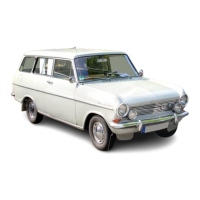Spare parts are available from many
sources; for example, Vauxhall garages, other
garages and accessory shops, and motor
factors. Our advice regarding spare part
sources is as follows.
Officially-appointed Vauxhall garages - This
is the best source for parts which are peculiar
to your car, and are not generally available (eg
complete cylinder heads, internal gearbox
components, badges, interior trim etc). It is
also the only place at which you should buy
parts if the vehicle is still under warranty. To
be sure of obtaining the correct parts, it will be
necessary to give the storeman your car’s
vehicle identification number, and if possible,
take the old parts along for positive
identification. Many parts are available under
a factory exchange scheme - any parts
returned should always be clean. It obviously
makes good sense to go straight to the
specialists on your car for this type of part, as
they are best equipped to supply you.
Other garages and accessory shops - These
are often very good places to buy materials
and components needed for the maintenance
of your car (eg oil filters, spark plugs, bulbs,
drivebelts, oils and greases, touch-up paint,
filler paste, etc). They also sell general
accessories, usually have convenient opening
hours, charge lower prices, and can often be
found not far from home.
Motor factors - Good factors will stock all
the more important components which wear
out comparatively quickly (eg exhaust
systems, brake pads, seals and hydraulic
parts, clutch components, bearing shells,
pistons, valves etc). Motor factors will often
provide new or reconditioned components on
a part-exchange basis - this can save a
considerable amount of money.
Modifications are a continuing and
unpublicised process in vehicle manufacture,
quite apart from major model changes. Spare
parts manuals and lists are compiled upon a
numerical basis, the individual vehicle
identification numbers being essential to
correct identification of the component
concerned.
When ordering spare parts, always give as
much information as possible. Quote the car
model, year of manufacture, body and engine
numbers as appropriate.
The Vehicle Identification Number (VIN)
plate is riveted to the top of the body front
crossmember, and can be viewed once the
bonnet is open. The plate carries the VIN and
vehicle weight information, and paint and trim
colour codes (see illustration).
The engine number is stamped onto a
machined flat on the front face of the cylinder
block (see illustration).
The chassis number is stamped into the
body floor panel, between the driver’s seat
and the door sill (see illustration).
Buying spare parts REF•3
Vehicle identification plate
Engine number and VIN plate locations
(arrowed)
Chassis number location (arrowed)
REF
Vehicle identification numbers

